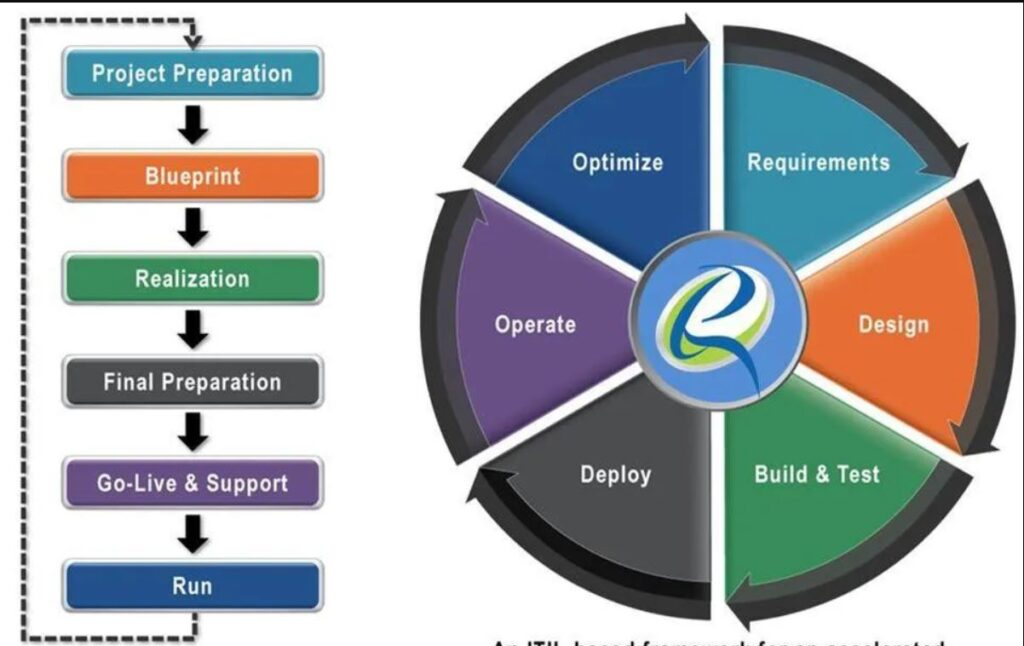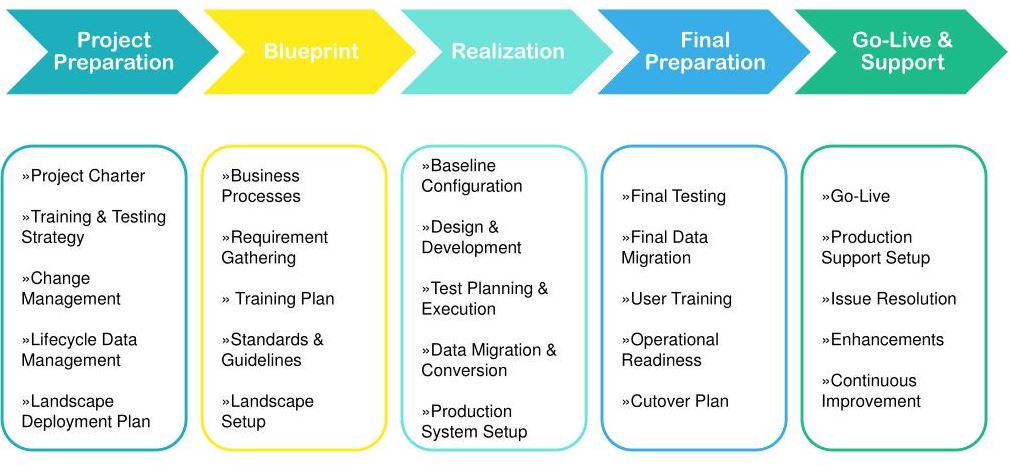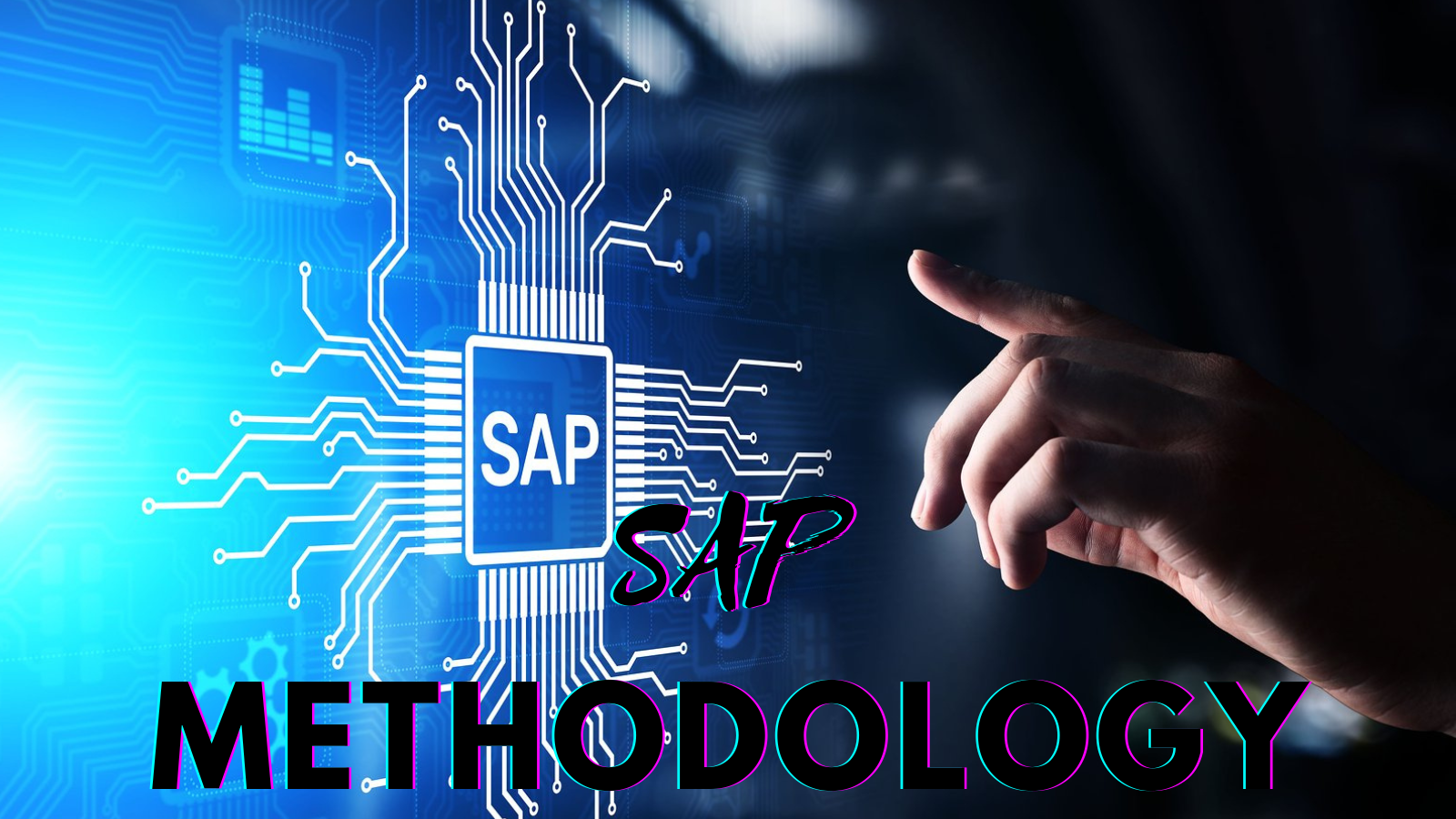SAP Methodology is a structured approach that guides organizations through the successful implementation of SAP software solutions. It encompasses a series of phases and activities designed to ensure a smooth and efficient deployment, enabling businesses to optimize their processes and achieve their desired outcomes.
The first phase of the SAP Methodology is Project Preparation, where organizations define project goals, assemble a project team, and conduct a thorough analysis of requirements. This phase establishes a solid foundation for the implementation process, including creating a detailed project plan, identifying risks, and aligning the project with the organization’s strategic objectives.
The next phase is the Business Blueprint, where the focus is on capturing and documenting the organization’s business processes, requirements, and customization needs. This involves conducting workshops and interviews with key stakeholders to gather insights and define the future state of the SAP solution. The outcome of this phase is a comprehensive blueprint that serves as a reference document for subsequent phases, ensuring alignment between business needs and the SAP solution.
The remaining phases of the SAP Methodology include Realization, where the system is configured and developed according to the business blueprint; Final Preparation, where data migration, system testing, and end-user training take place; and Go-Live and Support, where the SAP solution is deployed and transitioned into full operation. Each phase is carefully executed, following best practices and leveraging SAP’s extensive expertise, to ensure a successful implementation that meets the organization’s objectives.
In summary, the SAP Methodology provides a systematic approach to SAP software implementation, guiding organizations through the various phases to achieve optimal results. By following this methodology, businesses can streamline their processes, enhance collaboration, and leverage the full potential of SAP solutions to drive success.
Table of Content
Table of Contents
Introduction– SAP Methodology
The SAP Methodology encompasses several well-defined phases that guide organizations through a structured and successful implementation of their SAP solution. Understanding these phases is essential for organizations seeking to optimize their SAP implementation and achieve their desired outcomes. Let’s explore the key phases in detail, along with a diagram illustrating the SAP Methodology
SAP Methodology Phases:
- Project Preparation,
- Business Blueprint,
- Realization,
- Final Preparation

Introduction: SAP Methodology
SAP Methodology –Embarking on an SAP (Systems, Applications, and Products) implementation journey is a significant undertaking for any organization. It requires careful planning, meticulous execution, and adherence to a structured methodology. The SAP Methodology serves as a comprehensive guide, providing organizations with a roadmap to ensure a successful implementation. In this guide, we will explore the phases of the SAP Methodology and delve into how each step contributes to a seamless deployment. By understanding the intricacies of this proven methodology, businesses can optimize processes, drive efficiency, and unlock the full potential of their SAP solutions.
Implementing an SAP solution is not just a technological upgrade; it is a transformative process that impacts the entire organization. The SAP Methodology offers a structured approach to navigate this transformation, starting from project preparation and continuing through each phase of the implementation journey. During project preparation, the foundation is laid, goals are defined, and the project team is assembled. The subsequent phases, such as the Business Blueprint, Realization, and Final Preparation, focus on capturing requirements, customizing the system, and preparing for the go-live. By following the SAP Methodology, organizations can ensure alignment between business needs and the SAP solution, mitigate risks, and optimize outcomes.
The SAP Methodology provides a holistic framework that goes beyond mere technical implementation. It encompasses various aspects such as project management, change management, and user training. By following this methodology, organizations can streamline processes, improve data integrity, and enhance decision-making capabilities. The SAP Methodology also emphasizes the importance of stakeholder engagement and collaboration throughout the implementation journey, ensuring that key individuals and departments are actively involved and invested in the project’s success. With a clear roadmap and a well-defined methodology, organizations can navigate the complexities of an SAP implementation with confidence, minimizing disruption and maximizing the return on investment.
The SAP Methodology consists of several distinct phases that guide organizations through the implementation process, ensuring a structured and successful deployment of the SAP solution. Understanding these phases is essential for organizations seeking to optimize their SAP implementation and achieve their desired outcomes. Let’s explore the key phases in detail:
Phases of the SAP Methodology
Phase 1: Project Preparation – Setting the Foundation for Success
The Project Preparation phase marks the initial stage of an SAP implementation project. It involves defining project goals, scope, and objectives while assembling a dedicated project team. During this phase, a comprehensive project plan is developed, including resource allocation, timelines, and milestones. By conducting a thorough analysis of the organization’s requirements and aligning them with the SAP solution capabilities, organizations can lay a strong foundation for the subsequent phases of the implementation journey.
The SAP Methodology provides organizations with a systematic approach to SAP implementation, ensuring that each phase is carefully executed for a successful outcome. By following the Project Preparation phase and creating a comprehensive Business Blueprint, organizations can lay a solid foundation for the subsequent phases, enhancing the chances of a smooth and efficient implementation. The diagram visually represents the flow of the SAP Methodology, highlighting the progression from Project Preparation to Business Blueprint and indicating the logical sequence of the phases. Leveraging the power of the SAP Methodology, organizations can optimize their SAP implementation, align business processes, and achieve their desired goals.
Phase 2: Business Blueprint – Mapping Processes and Requirements
The Business Blueprint phase focuses on capturing and documenting the organization’s business processes, requirements, and customization needs. This phase involves workshops and discussions with key stakeholders to gather insights and define the future state of the SAP solution. The result is a detailed blueprint that outlines the system’s configuration, data structures, and interfaces. This comprehensive documentation serves as a reference point for the subsequent phases and ensures alignment between business needs and the SAP solution.
The Business Blueprint phase involves capturing and documenting the organization’s business processes, requirements, and customization needs. This phase includes conducting workshops and interviews with key stakeholders to gather insights and define the future state of the SAP solution. The outcome is a comprehensive blueprint that outlines the system’s configuration, data structures, and interfaces. The Business Blueprint serves as a reference document for the subsequent phases, ensuring alignment between business needs and the SAP solution.

Phase 3: Realization – Building and Customizing the SAP Solution
In the Realization phase, the focus shifts to the actual development and customization of the SAP solution. This phase involves configuring the system according to the requirements defined in the Business Blueprint. It includes activities such as system setup, integration testing, data migration, and user training. Throughout this phase, close collaboration between the project team and SAP consultants is crucial to ensure that the system is tailored to meet the organization’s specific needs. Rigorous testing and quality assurance are conducted to ensure that the SAP solution functions as intended.
Phase 4: Final Preparation – Testing, Training, and Readiness Assessment
The Final Preparation phase prepares the organization for the go-live of the SAP solution. This phase encompasses end-user training, data migration, system testing, and cutover activities. Thorough testing is conducted to validate the system’s performance and ensure data integrity. User acceptance testing allows key stakeholders to provide feedback and address any issues before the final go-live. It is also essential to assess the organization’s readiness for change, ensuring that end-users are equipped with the knowledge and resources to leverage the SAP solution effectively.
Conclusion:
Mastering the SAP Methodology is essential for organizations embarking on an SAP implementation journey. By following the structured approach of the SAP Methodology, businesses can ensure a successful deployment of their SAP solution. From project preparation to go-live and beyond, each phase plays a crucial role in aligning business processes, capturing requirements, customizing the system, and preparing for the transition. Understanding and implementing the SAP Methodology empowers organizations to unlock the full potential of their SAP solution, driving efficiency, and achieving operational excellence in today’s dynamic business landscape.



